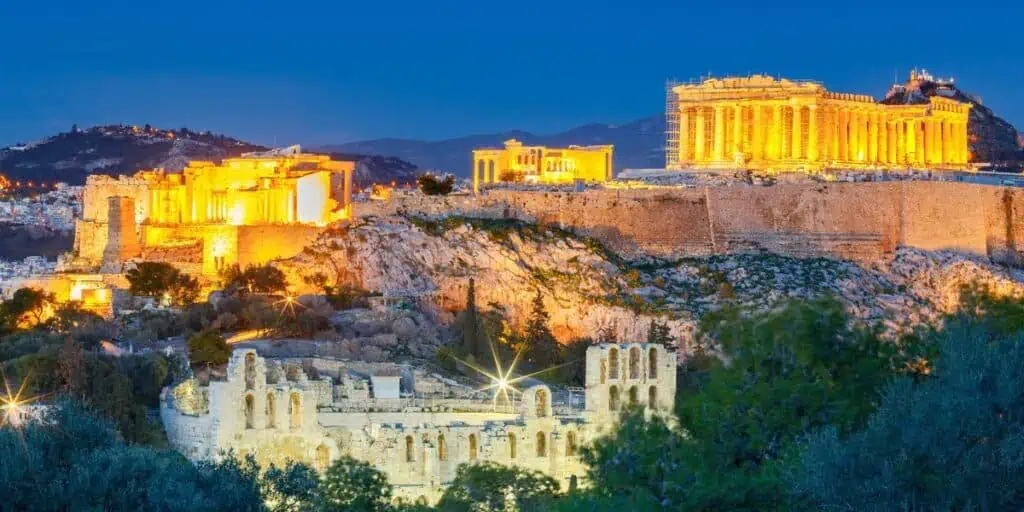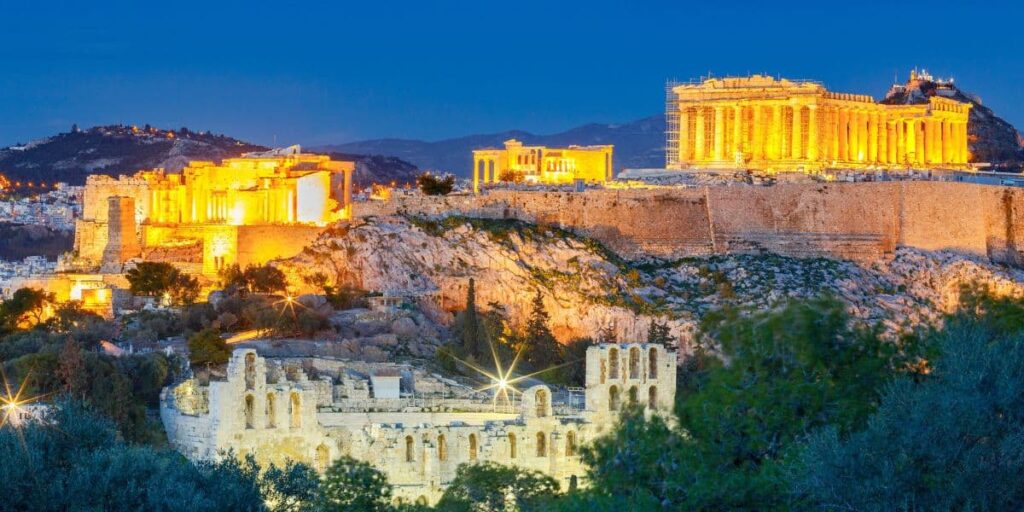Athens is one of the oldest living cities in the world. Even with high expectations, visiting the ‘Home of Democracy’ leaves you in wonder and excitement. This article covers famous landmarks in Athens, a must on any Greece itinerary.
For a DIY sightseeing tour of these ancient ruins, I recommend purchasing the combo ticket to access the Acropolis, Roman Agora, Hadrian’s Library, the Ancient Agora, Aristotle’s School, Olympieion, and Kerameikos. Separate tickets are available for other sites.
If you are deeply interested in Greek history, I recommend a guided tour of the Acropolis. This famous site has many monuments worth seeing, and a knowledgeable guide will help you understand their history.
Acropolis and the Parthenon
The Greek root acro means “high;” thus, an acropolis is a “high city.” The Acropolis of Athens is the most visited attraction in Greece and the most famous landmark in Athens. It is the most striking ancient Greek monumental complex that still exists today. Settlements at the Acropolis of Athens site can be traced back to the 4th Century BCE.
The Acropolis site has many monuments to visit, the most famous of which is the Parthenon. The Parthenon was a temple dedicated to the goddess Athena. Its construction began around 447 BCE when the Greek Empire’s prosperity peaked. Despite its age and numerous historical events, the Parthenon is an enduring symbol of classical Greek civilization.
Whether you book a single ticket or a combo ticket that includes the Acropolis, you need to book a time slot to visit this popular attraction as well. It is best to visit it early in the morning when it opens or early evening. As part of our Athens 3-day itinerary, we visited this site during the evening and stayed there for a couple of hours, almost until sunset.
Mid-afternoons should be avoided, especially in summer months. A private guided tour will also bring this site’s history alive and give context to its impact on Greek civilization over the years.
Erechtheion and the Temple of Athena Nike

These two monuments also are a part of the Acropolis site.
The Erechtheum, also known as the Erechtheion, was dedicated to Athena and Poseidon. Its notable feature is the Porch of the Caryatids’ beautifully sculpted female figures. Its distinctive design combines Ionic and Doric elements and houses multiple shrines.
The temple here was dedicated to the goddess Athena Nike, the bringer of success in battle. Its graceful design and intricate friezes showcase the artistic achievements of ancient Greece. Built around 420 BCE, it currently stands as the first fully Ionic temple at the Acropolis of Athens.
Odeon of Herodes Atticus

The majestic Odeon of Herodes Atticus lies on the southwest slope of the Acropolis of Athens. This theatre was built in 161 C.E. by Herodes Atticus in memory of his wife, Aspasia Annia Regila. During its 106 years, it could accommodate crowds of up to 5000 people.
There are two entrance gates to the Acropolis site. Starting from the entrance near the Acropolis Museum, you will come upon the Odeon of Herodes Atticus first and then move on to the Parthenon. This theatre is open to the public when it hosts special concerts.
Acropolis Museum

Unlike the Acropolis site, this museum is enclosed and air-conditioned, so it is a great option for afternoon visits. However, the Acropolis Museum requires a separate ticket, not part of our purchased combo ticket.
The three-story museum not only contains all the artifacts from the Acropolis site but also has a plethora of information about Greek history, mythology, and the chronology of events related to the Acropolis and Athens in ancient Greece. The Acropolis Museum is definitely worth a visit.
Ancient Agora

The Ancient Agora is an impressive site at the foothill of the Acropolis. In Ancient Greece, it was the center of Athens and served as a gathering place for its inhabitants. The Agora was established in the 6th century BCE and grew over centuries. The city’s administration was also located here. It housed shops, temples, and the Bouleuterion, where the 500-member city council sat.
You can cover the site in about 1.5 to 2 hours. The Temple of Hephaistos is one of the oldest buildings in Ancient Agora. Unlike the other structures, it is surprisingly almost intact.
The Temple of Zeus

The Olympieion, or the Temple of Olympian Zeus, was the largest temple in Athens and was dedicated to the god Zeus. Built in the second quarter of the 5th century BC, it was a model of the classical Greek temple of the Doric order.
The Temple suffered damage over time due to neglect and natural disasters. In the 5th century AD, only 16 of the original 104 columns were still standing. This landmark is one of the most commonly associated with Athens. It takes about an hour to explore. Hadrian’s Arch, once the city’s main gate, stands north of the Zeus Temple site.
Roman Agora

Roman Agora is a much smaller site than the Ancient Agora and takes only 15-30 minutes to explore. The Ancient Agora was a place of political gatherings for the Athenians in Ancient Greece, while the Roman Agora was the area’s open market. The Tower of the Winds is a tall, octagonal building immediately east of the Roman Agora.
The Library of Hadrian is located north of Roman Agora. Roman Emperor Hadrian created Hadrian’s Library in AD 132 on the north side of Athens Acropolis.
Kerameikos Ancient Cemetery

This Cemetery of Ancient Athens is one of the least visited archaeological sites in Athens. The 11-acre site is filled with tombstones and statues of astonishing design and quality. Archaeologists have found columns of temples, marble statues, remains of public buildings, funeral offerings, and thousands of tombs here. There is also a small museum on the site.
National Archeological Museum

If you have visited the Acropolis Museum, why visit another museum? The National Archaeological Museum houses the largest and one of the most significant collections of sculpture of Greek antiquity worldwide, dating from the 7th century BC to the 5th century AD. Acropolis Museum focuses on the Acropolis’s finds, while the National Archaeological Museum collects significant finds from all over Greece.
The works of art at this museum come from Greece, Cyprus, Egypt, Italy, and other areas, offering an overview of the ancient Greek world and its contacts within the ancient world. Some of the significant exhibits include the treasures of the royal tombs of Mycenae, the Linear B tablets, the enigmatic Cycladic marble figurines, and the excellently preserved wall paintings of Thera that comprise large pictorial compositions.
Panathenaic Stadium

The Panathenaic Stadium, or Kallimarmaro, is a multi-purpose stadium in Athens, Greece. One of the main historic attractions of Athens is that it is the only stadium in the world built entirely of marble. The stadium was built in the 4th century BC and restored for the first modern Olympic games in 1896.
This ancient-turned-modern stadium is a draw for lovers of classical architecture and sports fans. With a ticket purchase, you can enter the stadium and walk around, getting acquainted with its history. The best hours to visit the Stadium during summer are in the morning and late afternoon when the temperature is low.
Lycabettus Hill

Lycabettus Hill is the highest point in the center of Athens. Thousands of Athenians and tourists climb to the top every year to enjoy the view. At 277 meters (908 feet) above sea level, its summit is the highest point in Central Athens, and pine trees cover its base. Mount Lycabettus offers sweeping, unhindered views of the entire city stretching out to the Aegean.
You can hike a mile to reach this hill, take a taxi nearly to the top, and then walk from there.
Famous Landmarks in Athens

With this, we have covered important archaeological sites in Athens and the famous landmarks in the city for amazing views. Greece is a treasure trove of ancient sites that are not restricted to just the capital city. For the culturally inclined, you can also explore many more archaeological wonders as easy day trips from Athens.
Shweta has always been passionate about travel and immersing in new experiences. Having been to over 40 countries, she blogs at Zest In A Tote to bring family-friendly itineraries and tips, destinations, and luxury stays to her readers. Her belief in family travel needn’t be boring and one can do a mix of local culture & food, adventure activities and relaxation, all with family.

